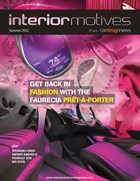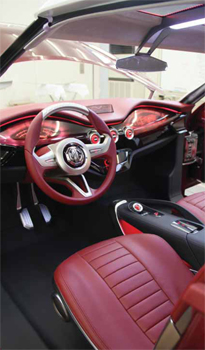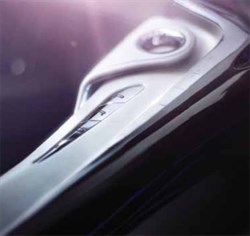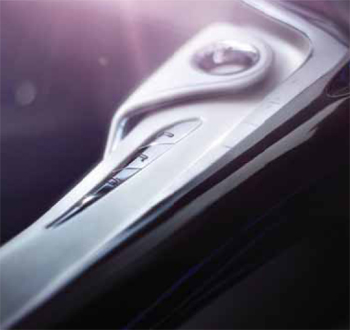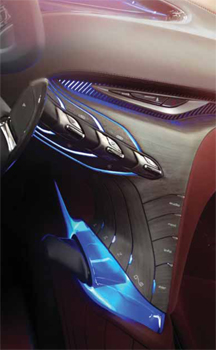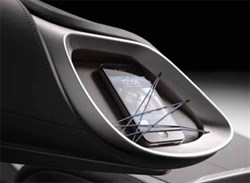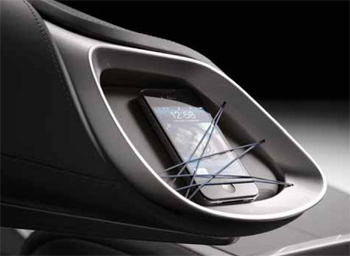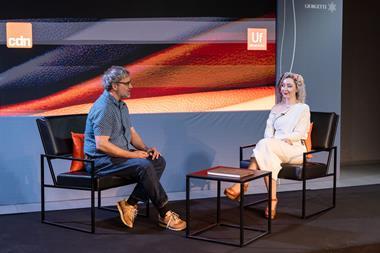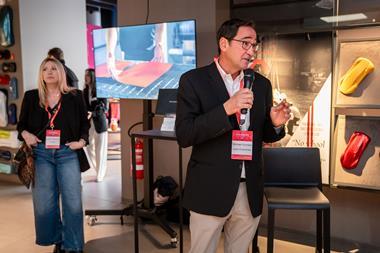IN THIS ISSUE
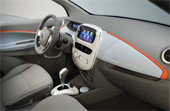 Vehicle type production/electric supermini
Vehicle type production/electric superminiDesign manager Agneta Dahlgren
Interior designer Dominique Marzolf
Colour & trim designer Catherine Joly
Project started spring 2009
Project completed summer 2010
Launch: Geneva/March 2012
Supplier Component
Visteon/DIEC soft-touch IP trim
Antolin dashboard
Faurecia seats
With the Zoe, interior designer Dominique Marzolf chose a different direction to his colleagues and explored the way energy is created today, looking for a language that resonated with nature but also offered something more. “I tried to work with elements sculptured by the wind or water – like boats, a hydrofoil for example,” says Marzolf. On one hand, this led the designer towards objects that were completely smooth, but he also “wanted a mixed effect – tension in the surface along with the smoothness”. These images – water and a leaf in close up – extol that approach, but Marzolf also cites the example of a current F1 car, whose balance of smooth and crisp surfaces is realised without the aide of a designer concerned with the resulting aesthetic.
 Vehicle type concept/coupe crossover
Vehicle type concept/coupe crossoverDesign director Anthony Williams-Kenny
Project director Shao Jingfeng
Interior/colour & trim manager Lu Ying
3D/digital design manager Tang Mingxing
Project started July 2011
Project completed March 2012
Launch Beijing/April 2012
Supplier Component
Phiaro Inc. concept build
Bridge of Weir leather trim
The MG Icon coupe/SUV crossover concept shown at Beijing in April is based on the MG3’s front-drive platform. “In July 2011, we met with senior MG management from SAIC Group to discuss creating a concept that demonstrated MG as a modern brand in a modern context,” reveals MG design director Anthony Williams-Kenny. “The project fi nished about a month before the Beijing motor show, at the end of February. It was really pressured in terms of time throughout the project but we aimed for a relatively early finish date… and for once it was quite comfortable.” Shown here is a photograph of an unpainted approval clay prior to review. “We did a huge amount of the work in-house, including the A-surfacing,” says the British designer.
The final design has a very sporty, sculptured feel and a layered fascia design. Sandwiched between the red leather upper dashboard surface and the dark grey leather bottom is a dual-screen interface backlit in a rich, deep shade of red. “This was really important to us,” says Williams-Kenny.
 Vehicle Type: concept/electric sports car
Vehicle Type: concept/electric sports carHead of design: Shiro Nakamura
Design manager: Taisuke Nakamura
Interior designer: Bert Dehaes
Colour & trim designer: Gail Patrick
Project started: October 2010
Project completed: January 2012
Launch: Geneva/March 2012
Supplier Component
CGI concept build, seats & binnacle
Bridge of Weir leather (seats & IP)
Alcantara seat trim
Sefar titanium-coated floor cover
The interior design is separated into two environments with
contrasting colourways: Carbon Black leather for the driver
and Shark Gray on the passenger side. A floating centre
console separates the driver’s carbon-fibre pod, which is
finished in a translucent violet lacquer. “The main point of this proposal is a combination of soft and organic surfaces with very technical elements that divide the space into two different worlds,” reveals Nakamura. “It’s an asymmetrical treatment. When we say ‘double wave’, we don’t mean the shape; it’s more of a space definition with a different kind of function.”
The semi-aniline Napa leather centre console and passenger-side IP are fi nished in subtle iridescent pearl lustre to reinforce the sense of space. The lightweight theme of the interior is also accentuated through layering and hollow sections. The main aesthetic element is a
functional chromed and grooved floating ring. “You can cycle through different menus with it, but rather than a dial it’s a floating ring to communicate the lightweight expression,” says Dehaes. “The idea is that it has physical movement but also gives haptic feedback. The spiral detailing is also a signature that has been seen in Infi niti concepts before."
 Vehicle type: concept/electric hatchback
Vehicle type: concept/electric hatchbackChief designer Europe: Thomas Bürkle
Interior design manager: Sandy Hartono
Lead interior designer: Michel Glenisson
Interior designer: Eric-Yann Coulouvrat
Colour & trim designer: Ivana Hrudkova
Project started: January 2011
Project completed: February 2012
Launch: Geneva/March 2012
The i-oniq was billed at its 2012 Geneva show unveiling as an electric sports hatchback with a range-extending three-cylinder petrol engine. Led by Thomas Bürkle, chief designer of Hyundai’s European design team, the exterior styling of the 4,432mm-long coupé was never intended to be radical in statement but rather represent an evolution of the brand’s well-established 'fluidic sculpture' design language. The interior design had to reflect that sporting intent, and sprang from this key sketch by lead interior designer Michel Glenisson in early 2011.
The photograph of the centre console area reveal how many of the key buttons have been integrated into the console’s scored, segmented surface. The lines that separate these controls also help defi ne the console’s gentle changes in angle and direction.
 Type: two-seat interior demonstrator
Type: two-seat interior demonstratorHead of advanced design: Markus Uhlig
Advanced design manager: Julien Seiller
Lead designer: Leonardo Lopez
Colour & trim designer: Lisa Koch
Project started: May 2011
Project completed: October 2011
Launch: LA Auto Show/November 2011
Supplier Component
Rücker Designwerk concept build
Wrapping Solutions interior trim
Icon Incar HMI graphics
Tron Design seat modelling
Schröter/Merit electronics/HMI
The Prêt-à-Porter Interior Systems demonstrator was created by Faurecia for the 2011 LA Auto Show and showcases the French company’s venture into the world of fashion. Consisting of two seats, an instrument panel, console, driver’s door and flooring, it borrows elements of ‘ready-to-wear’ haute couture and applies them to the interior of a modern premium vehicle.
“This was a truly international project,” says Global Head of Advanced Design, Markus Uhlig. “We had people from Chile, from France and Germany, from America…and the concept is based on projected global market trends for the next 20 years. The theme is ‘Industrialised Craftsmanship’ and was generated by workshops at our studios in France and Germany – the whole team from both sides sat together.”
The board of research images focusses on the way that wood, leather and fabric are combined in contemporary furniture, as well as the trend for woven fabrics – both major sources of inspiration for Faurecia’s design team. Another key fashion trend adopted for automotive use inside the Prêt-à-Porter is the use of stretched thread for lightness.
Magazine
